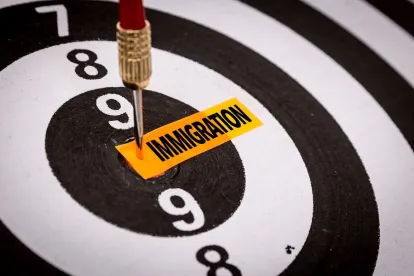A new version of the Form I-9 has been released by U.S. Citizenship and Immigration Services (USCIS). Employers may choose to use either the prior version (marked with a 7/17/17 revision date) or the new version (revision date of 10/21/19) until April 30, 2020 but must begin using the new version by May 1, 2020.
The new Form I-9 has no substantive changes; however, the instructions now clarify the definition of an authorized representative. The Form I-9 instructions state: “You may designate an authorized representative to act on your behalf to complete Section 2. An authorized representative can be any person you designate to complete and sign Form I-9 on your behalf. You are liable for any violations in connection with the form or the verification process, including any violations in connection with the form or the verification process, including any violations of the employer sanctions laws committed by the person designated to act on your behalf.” The instructions also further clarifies the use of N/A in Section 2. An employer does not need to write N/A in columns that are not being used for documentation.
Form I-9 Completion and Retention – Form I-9s are subject to Inspection
All U.S. companies must complete and retain the Form I-9 for all current employees, as well as for terminated employees for at least three years past the start date or one year past the termination date, whichever is later.
Companies’ I-9 forms are subject to inspection, and, notably, U.S. Immigration and Customs Enforcement (ICE) audits have increased nationwide. In FY2018, ICE Homeland Security Investigations (HSI) an investigative unit of Department of Homeland Security (DHS), opened 6,848 worksite investigations compared to 1,691 in FY17; initiated 5,981 I-9 audits compared to 1,360 the year before; and made 779 criminal and 1,525 administrative worksite-related arrests compared to 139 and 172, respectively. The current administration has increased staffing of ICE HSI to conduct comprehensive I-9 audits with increased issuance of “Notices of Inspection” (NOIs) under a directive by the current administration. Last year, ICE announced that over 3,000 NOIs were expected as part of a nationwide surge in ICE investigations in worksite enforcement.
NOIs are civil administrative audits that can carry fines from $230-$2,292 per form for substantive and technical uncorrected violations. In some cases, these civil audits can lead to worksite investigations that are criminal in nature, resulting in the more severe “raids” on employers as well as increased monetary penalties and potential imprisonment.
During the NOI process, the company only has three business days to turn over their I-9 forms, supporting documents, company information, ownership and payroll records, any applicable E-Verify account information and any SSN no-match letters, and contractor or staffing agency information, for review by ICE. These NOIs are a primary tool for ICE to conduct thorough investigations and are impacting a wide range of employers from small to large companies across all industries.
What an Employer needs to know for I-9 Compliance - before receiving a Notice of Inspection
As background, it is unlawful for an employer to knowingly employ an unauthorized worker, and the completion of the Form I-9 is a legal requirement for all new employees hired since November 6, 1986.
All U.S. employers are required to verify that the individuals they hire are authorized to work in the United States, including citizens and noncitizens, under the Immigration Reform and Control Act ("IRCA") of 1986 by completing the Form I-9. The Form I-9 is a required form used to verify employment eligibility for individuals hired within the United States. Failure to comply with these laws and regulations may result in ICE imposing criminal and civil sanctions upon employers.
Proactive steps for staying I-9 compliant
Employers should be diligent in having systems in place which address I-9 training, completion, storage, audits, and re-verification. More importantly, compliance training on how to conduct inspection of original, unexpired documents with a new hire is essential to fully train hiring managers, HR staff, supervisors, recruiters and anyone else involved in the hiring and onboarding process.
In addition, employers should implement an onboarding process that includes strict timeframes for timely completion of the Form I-9. Late completions will likely result in high fines: Section 1 must be completed by the first day of work, and Section 2 must be completed within three business days of the start date. Quick tip: the Form I-9 can be completed before the start date as long as there has been an official offer and acceptance by the new hire.
Going green with paperless electronic I-9 systems
Many employers are becoming more sophisticated with using electronic I-9 forms instead of paper forms. However, they should carefully vet systems for compliance with the electronic I-9 regulations, including review of the system’s security, indexing capability, audit trails and electronic signature requirements, and utilize a well-designed electronic I-9 system which will enable employers to ensure forms have been filled out properly and are up-to-date.
An electronic I-9 system can reduce the retention of paper I-9s as well as make the process more efficient for many employers. Even with an electronic I-9 System, it is critical for employers to conduct regular training sessions with individuals responsible for the completion and retention of I-9 forms. ICE may also request access to a company’s electronic system through an I-9 Demo to confirm compliance.
Self-audits with outside counsel with I-9 expertise
Due to the uptick in I-9 audits and investigations, employers should conduct internal audits of their I-9 records on a regular basis. Internal audits help employers stay in compliance with the laws and regulations set forth by the government. It is a best practice for employers to conduct self-audits under the guidance of experienced counsel who can assist with answering questions related to employment verification, spot and address recurrent issues, and develop a remediation plan if errors are present. A remediation plan can help employers address critical issues on I-9 forms and limit exposure in the future. Being proactive can help alleviate serious penalties and fines in the event of an ICE audit.
What to expect once you have received a NOI?
ICE can compel a review of an employer’s I-9 forms and related documents by serving the employer with a NOI. Generally a NOI will seek production of all I-9 forms for current and terminated employees, any policies and procedures in place related to employment eligibility verification (I-9/E-Verify), list of current and terminated employees (ICE may ask for a specific date range), business licenses, payroll data, and copies of correspondence from the Social Security Administration office regarding any mismatched or no-matched social security numbers.
Once the employer has been served a NOI, the employer will usually be provided three days to respond to the government’s request. The employer should contact their counsel immediately. NOIs should be taken with the utmost priority and their response submission should be well-organized for the government. Failure of compliance may result in hefty fines.
What is a SSN No-Match Letter?
Employers should also be on the alert for SS No-Match letters which have re-emerged last year as part of an increased focus on compliance.
In early 2019, the Social Security Administration (SSA) office resumed the process of sending letters to employers to advise if an employee’s Form W-2 did not match the SSA’s records. Approximately 575,000 employers have received these no-match or correction request notices. A no-match letter, formally known as an Employer Correction Request (EDCOR), informs an employer where at least one name and Social Security Number (SSN) combination on a W-2 submitted by the employer do not match SSA’s records.
The letters do not identify by name specific employee(s) who have incorrect information within the system. If an employer receives a no-match letter, it must first register for the SSA’s Business Services Online (BSO). Once registered with BSO, an employer can log on to view and correct the name and SSN errors. The employer should take these necessary steps to correct the information:
-
Check the reported no-match against personnel records;
-
Inform the employee of the notice;
-
Ask employee to confirm his or her name and SSN. If the exact name or SSN was not previously reported, correct it on a Form W-2C;
-
Advise employee to contact SSA and accordingly update their SSA records to resolve the issue. Have the employee notify you once it has been resolved;
-
If an employee can’t resolve the no-match error for his or her name or SSN, consult legal counsel about how to proceed.




 />i
/>i

